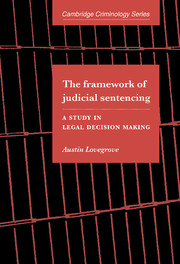Book contents
- Frontmatter
- Contents
- List of figures
- List of tables
- Acknowledgments
- 1 Judicial decision making and sentencing policy: continuation of a study
- 2 A sentencing decision model: single and multiple similar counts
- 3 A sentencing decision model: multiple disparate counts
- 4 Testing the decision model for multiple disparate counts
- 5 The techniques of data collection
- 6 Judges' thoughts on sentencing the multiple offender
- 7 An alternative sentencing decision model for the multiple offender
- 8 Validity and development of the alternative decision model: the data collection
- 9 Towards a requisite decision model for sentencing the multiple offender
- 10 The armature of judicial sentencing
- Appendix 1 Case 37 from Sentencing Research Exercise – Part 3B
- References
- Index
5 - The techniques of data collection
Published online by Cambridge University Press: 22 August 2009
- Frontmatter
- Contents
- List of figures
- List of tables
- Acknowledgments
- 1 Judicial decision making and sentencing policy: continuation of a study
- 2 A sentencing decision model: single and multiple similar counts
- 3 A sentencing decision model: multiple disparate counts
- 4 Testing the decision model for multiple disparate counts
- 5 The techniques of data collection
- 6 Judges' thoughts on sentencing the multiple offender
- 7 An alternative sentencing decision model for the multiple offender
- 8 Validity and development of the alternative decision model: the data collection
- 9 Towards a requisite decision model for sentencing the multiple offender
- 10 The armature of judicial sentencing
- Appendix 1 Case 37 from Sentencing Research Exercise – Part 3B
- References
- Index
Summary
In the previous chapter the model describing how judges reach sentencing decisions in cases comprising multiple disparate and separate counts was used to derive hypotheses so that it was possible to test this model by means of a series of sentencing problems. This chapter describes how the data were collected for this purpose. Three sets of data were used, each set generated by a different technique, although the sentencing problems provided a common framework within which these three techniques were applied. The three techniques were: (1) sentences imposed by a sample of judges for the cases in the sentencing problems, to investigate which aspects of the model were consistent with the judges' sentencing behavior and which were not; (2) verbal protocols based on immediate retrospective reports and providing direct, detailed and accurate information on the content and sequence of the judges' thoughts as they worked through the sentencing problems; and (3) reflective retrospective reports in which the judges were asked to comment on whether the various elements of the model were accepted by them as valid descriptions of the method to be adopted when sentencing the multiple offender. For these three techniques of data collection, the judges in the sample were tested individually.
Each of the three techniques is now described, justified, and its place in the testing of the model explained, in turn. Following this, the procedural details relating to the administration of these techniques are described.
- Type
- Chapter
- Information
- The Framework of Judicial SentencingA Study in Legal Decision Making, pp. 78 - 98Publisher: Cambridge University PressPrint publication year: 1997



